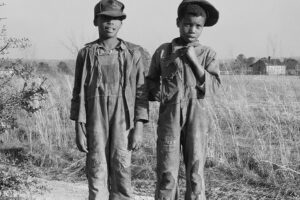NEW YORK (CNS) — The filmmakers behind the illuminating documentary “Riveted: The History of Jeans” want viewers to avoid taking that celebrated form of apparel for granted.
Thus freelance journalist James Sullivan observes, “You don’t stop to think about why half the population is wearing them on any given day.”
Written, produced and directed by Anna Lee Strachan and Michael Bicks — a duo more closely associated with the series “Nova” — the film debuts Feb. 7, 9-10 p.m. on PBS as an “American Experience” presentation. Broadcast times may vary, however, and viewers should consult their local listings.
Despite their status as, in the words of Melissa Leventon, a former curator for the Fine Arts Museums of San Francisco, the “quintessential American garment,” the origin of jeans is widely misunderstood. As fashion historian Emma McClendon puts it, “denim has been around much, much longer than the Gold Rush and (Levi) Strauss.”
The garb’s true background takes in a worldwide geography, one that’s hinted at in the variety of names by which it’s known. Thus the Indian town of Dungri gives us the term dungarees while the word denim can be traced back to Nimes, France. As for the more general moniker jeans, it originated in the practice of using of sail cloth to make trousers in Genoa, Italy.
The characteristic color was provided by indigo dye. South Carolina plantation owner Eliza Lucas is credited with introducing this cash crop into colonial America. Its successful cultivation, however, depended on the expert familiarity enslaved African Americans were able to deploy in working with it, a skill they had acquired in their home nations.
A more familiar aspect of the story began in Reno, Nev., in the 1870s when a tailor named Jacob W. Davis, noticing that traditional work pants tended to fall apart easily, came up with the idea of reinforcing them with strategically placed rivets.
As the owner of a one-man shop, though, Davis lacked the wherewithal to mass produce his new creation. So he formed a partnership with Strauss. Patented in 1873, their “waist overalls” were destined to transform American culture.
To take just one example, by the 1930s, dude ranches had become popular in the West. They offered affluent women, clad in jeans, “the ability to get dirty” while hunting, fishing and riding horses.
According to Leventon, what had previously been a mark of working-class status thus became a symbol of wealth and leisure. More significantly, says Cornell University historian Adrienne Rose Bitar, some of the dude ranches’ female patrons began to “rethink their position in American society.”
The popularity of denim spread to other sectors of the population as well. Bikers wore dungarees as a sign of rebellion, for instance, while contemporary hip-hop artists sport baggy jeans as an emblem of cultural pride.
In connection with the discussion of slavery, artistic depictions of naked figures are shown. And a survey of advertising for jeans includes images of partial nudity. But the movie contains nothing really objectionable and can be endorsed for adults and mature teens.
Given its subject matter, some may assume, going in, that “Riveted” will be a light, frothy and glib presentation. Yet the same use of evocative still photographs and compelling archival footage that has characterized other “American Experience” projects elevates this one as well.
The documentarians, moreover, make a forceful case that, far from an exercise in trivia, the study of their chosen topic can help, in McClendon’s words, “to change our understanding of American history.” After watching their well-crafted and absorbing film, viewers are likely to agree with that assessment.
– – –
Byrd is a guest reviewer for Catholic News Service.
Read More Movie & Television Reviews
Copyright © 2022 Catholic News Service/U.S. Conference of Catholic Bishops






